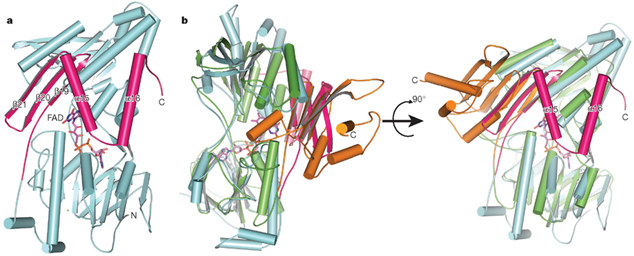Structural Insight into the Type-II Mitochondrial NADH Dehydrogenases
26-10-2012
The single-component type-IINADH dehydrogenases (NDH-2s) serveas alternatives to the multisubunit respiratory complex I (type-INADH dehydrogenase (NDH-1), also called NADH:ubiquinoneoxidoreductase;EC 1.6.5.3) in catalysing electron transfer from NADH to ubiquinone in the mitochondrial respiratory chain. The east NDH-2(Ndi1) oxidizes NADH on the matrix side and reduces ubiquinone tomaintain mitochondrial NADH/NAD1 homeostasis. Ndi1 is a potential therapeutic agent for human diseases caused by complex I defects, particularly Parkinson’s disease, because its expression restores the mitochondrial activity in animals with complex I deficiency. NDH-2s in pathogenic microorganisms are viable targets for new antibiotics. Using MX beamline (BL17U1) at Shanghai Synchrotron Radiation Facility, Maojun Yang group of Tsinghua University solved the crystal structures of Ndi1 in its substrate-free, NADH-, ubiquinone- and NADH–ubiquinone-bound states, to help understand the catalytic mechanism of NDH-2s. They find that Ndi1 homodimerization through its carboxy-terminal domain is critical for its catalytic activity and membrane targeting. The structures reveal two ubiquinone-binding sites (UQI and UQII) in Ndi1. NADH and UQI can bind to Ndi1 simultaneously to form a substrate–protein complex. They propose that UQI interacts with FAD to act as an intermediate for electron transfer, and that NADH transfers electrons through this FAD–UQI complex to UQII. Together their data reveal the regulatory and catalytic mechanisms of Ndi1 and may facilitate the development or targeting of NDH-2s for potential therapeutic applications.

Links:http://www.nature.com/nature/journal/vaop/ncurrent/full/nature11541.html


 Copyright©2006.12 Shanghai Advanced Research Institute.
Copyright©2006.12 Shanghai Advanced Research Institute.